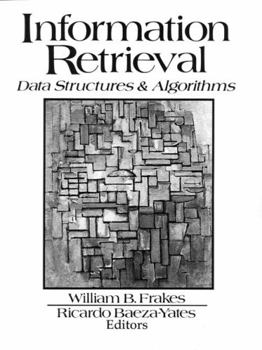Information Retrieval: Data Structures and Algorithms
Select Format
Select Condition 
Book Overview
Information retrieval is a sub-field of computer science that deals with the automated storage and retrieval of documents. Providing the latest information retrieval techniques, this guide discusses... This description may be from another edition of this product.
Format:Paperback
Language:English
ISBN:0134638379
ISBN13:9780134638379
Release Date:January 1992
Publisher:Pearson
Length:512 Pages
Weight:2.00 lbs.
Dimensions:1.1" x 7.0" x 9.2"
Customer Reviews
3 ratings
Useful reference book
Published by Thriftbooks.com User , 22 years ago
I bought this book while working on some informaitno retrieval related project, and it turned out as a useful reference for explaining terminology, suggesting efficient data structures, and offering good references for further reading.However, the book turned out yet more useful to me as, during my M.A. studies (in CS) I had to write a work on "Suffix Trees" and "Suffix Arrays" and I found that Gonnet, Baeza-Yates and Snider describe equivalent ideas they call "PAT trees" and "PAT arrays".I found this book useful too for working on computational linguistics related projects as well.In short - I like keeping this book always in reach, as a reference, though, I found this book not so friendly as an introduction book to the subject ("Managing Gigabytes", might turn out to be a more welcomming).
Good coverage and treatment of algorithms for I.R.
Published by Thriftbooks.com User , 25 years ago
I adopted this book as the primary textbook for my course on information retrieval. It covers a substantial part of core topics in IR: models of information retrieval system (boolean and best-match systems); implementations (inverted files, tries, signature files, hashing), indexing and retrieval algorithms (lexical analysis, stemming, ranking, relevance feedback, boolean operations) and somewhat more advanced topics like clustering and automatic thesaurus construction. These topics are dealt with varying level of detail: for some of them there are also C code examples that are rather useful to students; other topics are less well detailed (eg. relevance feedback and probabilistic models). These topics are dealt with sufficient clarity and reasonable conciseness. Some shortcomings are: (i) the weak treatment of the probabilistic models (I would have liked a deeper analysis of the underlying principles and how they lead to certain kinds of systems). Consequences of some techniques are discussed with insufficient depth. (ii) In my view too much attention is devoted to low-level string processing, like what is done in chapter 10, centered on string searching algorithms (not relevant to the main topic of the book). (iii) Other important topics have not been dealt at all, unfortunately. These include almost everything that goes under the topic of user-centered information retrieval and user interfaces. Another missing topic is "passage retrieval".
good tips on how to get the right bits of knowledge to user
Published by Thriftbooks.com User , 27 years ago
Although this is more of a hardcore software book, the techniques and issues presented are transferable to the general problem of knowledge management. In particular, the various software tricks for how to handle very large databases provide useful ideas on how to get the right bits of knowledge to the user.





